Preface – Mortality
The facts are we are mortal, and so are our animals. The topic of domesticated animals and their care is a sensitive one with almost cult-like division over everything from when to call a vet vs. whether or not to blanket a horse. Internet flame wars reach inferno proportions when animal care is the topic.
Animal husbandry is a low calling and a high honor. To be “called” means to place our personal needs lower than shit on our list of priorities. Literally. Unlike children, who reach elevated levels of independence over time, our animals will never reach a point of fending for themselves on a day to day basis so that mommy can go have an evening out with the ladies. You can throw a 15 year-old-kid ten bucks and they can find a happy meal and manage to probably live through the evening unattended. Give a horse ten bucks and they’ll likely eat it and shortly after develop life-threatening colic. Mommy gets a night out only after the animals are tended to. And ends her night out checking on the animals when she returns.
As with any calling the decisions we make are simple and personal. A “called” religious person can enjoy a level of hypocrisy with impunity and the promise of forgiveness. A person who takes on the yoke of animal husbandry can never be a hypocrite. They live exactly as they believe, unable to afford the luxury of giving two scoops of chicken manure what anyone else believes, and living without forgiveness for the times they fail to live up to what their charges require.
Not that animals are unforgiving. They’re infinitely forgiving. Their physical bodies might not be, and we are not forgiving of ourselves. But animals? They forgive and forget with a capacity that might only be rivaled by Jesus. Maybe. I mean, God was a resentful smiter back in the Old Testament, so I think He needed to learn forgiveness over time, whereas I’ve never been smited by a critter.
Anyway.
Our Policy on Horses
I’ve held a policy that I wouldn’t write on this blog or on our Facebook page if any of our trail horses die. Outfitters are portrayed as people who dispose of their animals as soon as the beast can no longer turn a profit. They list them on Craigslist, at best, but most often just send them to the feedlot until the slaughter truck picks the horses up. They turn ’em and burn ’em. At least, that is the perception. Of the outfitters I’ve known, this has never been the case.
I want to be transparent with you — you ARE guests and as our guests it is our deepest desire that you bond with our horses, even temporarily. You contacted us in order to experience horses — maybe to overcome a fear, maybe because you rode as a child, or maybe just because you thought riding a horse sounded novel and fun. No matter the reason, every single person who’s come our way has treated our horses with reverence and kindness. I feel like we shared a moment and experience — you, me, and the horses — and it’d be wrong not to make their major life events accessible to you. We owe you that.
I could set up a small profit center from the folks who’ve offered to shovel manure for us, just because they want to experience some of the less glamorous aspects of animal husbandry. The horse shit is minor. It’s the moments of pain, the injuries, the frustration when you find mold in a bale of hay or find that a saddle is soring a horse that is the painful aspect of horse ownership. It’s the mysterious pains that come and go, the hoof abscesses, the inability to control the weather, and the goddamned horseflies that will keep you up at night.
And the decision to put a horse down.
So, here’s my policy: when a horse’s life options become so limited that it can no longer work, I’ll put it down.
Here’s why:
- I believe when you sell a horse, you release ownership and claim and responsibility and any hope of intervention for that horse. It’s out of your care. Great if a horse is sound, young, vice-free, and gentle. Its chances for a good, long-term, caring home are great. Take a horse that is not guaranteed sound, no matter how gentle, and (especially with the current market) the horse’s options are dramatically limited. Add medical needs to the equation and your horse is probably headed down a painful road to the slaughter.
- The path to slaughter is an ugly one. The unsound horse is practically given away. The recipient (who was looking for a cheap horse because they couldn’t afford to buy a sound horse) is always one vet bill away from destitution, or one ton of hay away from missing their rent, or one medical issue away from being unable to care for the horse. The owner is too devastated and ashamed to seek help. Later, rather than sooner, the horse is removed from the situation — probably emaciated and in pain. The horse is first shipped to a feedlot where it is frightened, knee deep in shit, and probably still in pain. Soon, the horse is cramped into a trailer with 40 other terrified horses, and hauled for 30 hours to Mexico (that is, if it’s lucky and doesn’t get dumped in the desert in New Mexico). And then it is herded down a chute, terrified, and shot with a bolt in its forehead. If it’s lucky (which, really, how lucky is it to have come this far?) the first bolt is fatal.
- I feel it’s important to be with my horses when they die. I also feel it’s important to make the decision to put a horse down to shorten their period of suffering.
- Chronic pain is debilitating. If a horse is in that much pain, the humane thing is to peacefully and respectfully end the suffering.
So, yeah, we lost a horse.
It’s a sensitive thing and I’m all kinds of defensive as I write this, but on Saturday night we lost a horse. In fact, I called a vet and knew before she got there that we needed to put our sweet USA down. So, we didn’t lose her, we put her down.
I’d been struggling with where USA was in her career. I knew that she probably needed to retire soon, she’d been having a hard time keeping weight on and seemed to spend more time laying down than I remembered. Typical of Tennessee Walking Horses, she was developing a sway to her back. I dewormed her, had her teeth floated (a dental procedure), vaccinated her, gave her senior feed. I waited for her to give me an unmistakable sign that she needed to retire. USA, our noble black mare and most photographed horse, trucked on.
We held Cowboy Camp last week. It’s a low-impact week of exposing kids to horses, teaching them to lead and ride horses, and working up to a trail ride through the vineyards, with the kids riding their own horse by themselves. USA was in her element – fawned over by children, ambling through the obstacle course, and eventually meandering among the vineyards. We were all so proud of the horses, including USA. Each of the horses provided a very special experience for the kids and did it with such grace and kindness that every time I saw a bobble-headed helmeted kid atop our horses, I was overwhelmed with emotion. Every folktale you’ve heard of horses being especially gentle and careful around children came to life last week.
God this is a long post. I’m making up for lost time, it’s been months since I’ve posted. But, talking about putting a horse down (a horse that belongs to our guests, really) is important, and requires explanation.
I came home Saturday night from a Buck Brannaman clinic and saw USA laying down. Again. As I often do when a horse lays down, I went and checked on her. Temperature was normal, but heart rate and respirations were elevated. I could see by her grimace she was in pain, and her vitals proved it. I held my stethoscope to her tummy. Silence. I moved it all around her flanks, waiting for the tell-tale gurgle and swish that would tell me her gut was working. When I heard nothing I told myself it was because I had a cheap stethoscope and wasn’t professionally trained (despite the fact that most days you could hear USA’s gut happily digesting hay with celebratory farts and gurgles from about a half-mile away).
The first rule of thumb with a horse that’s laying down and in pain is to get the horse up and on its feet. This is not an easy task to perform or watch, as it requires urgent encouragement. Some horse owners will even resort to pouring water down a horse’s ears or nose to get the horse to get up. The horse often responds with a panicked burst of thrashing as they feel like they’re drowning, but they often get up. Crude, but effective.
I didn’t do that. But I’m not saying I wouldn’t if it came to it. Fortunately, USA is a damn stubborn and tough-minded horse. For the amount of pain she felt, I only had to tug on her halter and give her a couple of whacks with the broom for her to stagger to her feet. She pooped, passed gas, and peed. Maybe I really did miss hearing some gut sounds and she would be fine! Horse shit never made me happier.
The next order of business was walking, electrolyte paste, and pain killer. Surely we were on the path to recovery. I walked her down to the grain bin that she constantly tries to crack open. USA’s lips were more dexterous than my thumbs, she probably could’ve been a diamond thief, thought she’d only have been interested if the diamonds smelled like molasses. Normally it took some creative twine-work and bungy cords to keep her out of the grain bin. Yet, Saturday night as I walked her down there she merely sniffed at the bin and returned to uncomfortable panting and pacing. USA hurt too much to eat. For you who’ve ridden her, you now that USA enjoyed eating as much for the food as for just knowing she could get away with it. A USA without an appetite was like a fish with an aversion to water.
I called the vet. It was 11:30 by then.
I knew the drill. We’d intubate her, give her some mineral oil, pain killer, maybe a tranquilizer. I was looking at a long night was all. She’d be okay, though I was sorry for the pain she felt. The vet would tell me my stethoscope was crap and I’d totally missed some glaring signs that USA was obviously going to be fine.
Though, I did also scope out appropriate places to take her that would be out of site of the neighbors in case we needed to put her down.
“She’s not a candidate for WSU, I’m not sure she’d make the trip up there” said the vet after a brief listen to USA’s stomach, lungs, and heart.
I knew. I knew that if we saved USA then, that she’d be back on the ground in the morning, struggling and in pain. I don’t know specifically what the look is or what the signs are, but after watching my mother die of ALS and my brother die of cancer, I guess you could say there’s a “feel” you get when a life is reaching its end. Like love and birth, you just know. The vet articulated what I knew and didn’t want to admit.
I was crying before the vet finished her statement. I can’t tell you how many animals I’ve hunted, butchered, put down, or seen dead. Yet it never is comfortable or easy or routine.
The vet went to her truck as I led USA to her spot. I pet her neck, but she was restless and panting. Her black coat was dry and cool even though her temperature had risen. She was dehydrated. I apologized to her. Her electrolytes at that point were all over the map. Her muscles twitched, yet despite her pain she made every attempt to remain careful of me as I wrapped my arms around her neck and buried my face in her mane for just a minute. It wasn’t about my pain, it was about hers. I released her and we began pacing again until the vet returned with the necessary medication to finally ease USA’s suffering.
USA passed just as she lived – quiet, strong, and graceful. I held my hands on her neck and waited for her heart beat to stop and her eyes to not respond, making sure that USA passed with love surrounding her. As her steward, and in a way her servant, it was the best I could offer her.
Rest In Peace, USA.

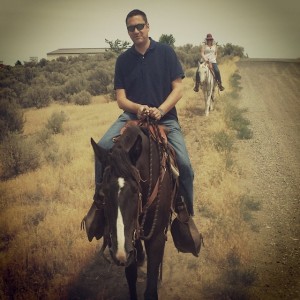
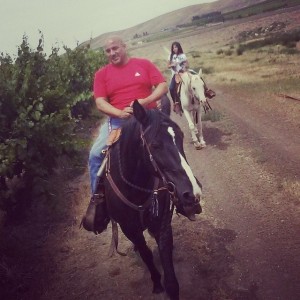
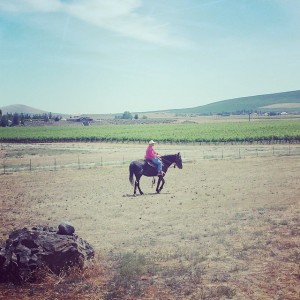
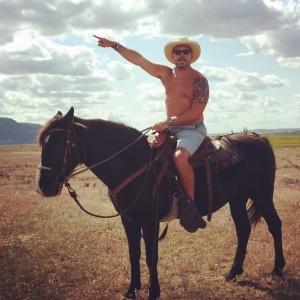
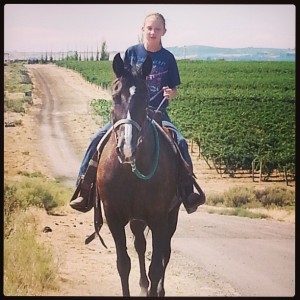
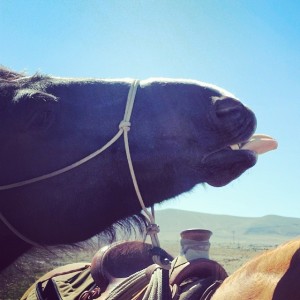
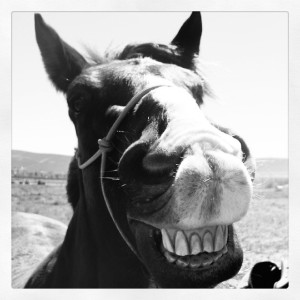

6 Responses to Facing Fears and Facts